OK, hats were too limiting. So, instead there will be the clothing or apparel of the day. Today’s blue latex examination gloves were an easy choice. They were the only item all of us lab folks had in common. The high school students who are also part of the project took Sharpies and decorated their gloves that’s how much fun we were having that day!!
A couple of quick notes: -I mentioned surface archaeology yesterday without explaining that as soon as my shovel hit gravel, I was doing sub-surface archaeology. Sub-surface archaeology simply means below ground level.
-I posted an activity, Bedroom Archaeology, in the Learning Resources section of the website. You can find it on the top toolbar, far right side.
Lab Work
Lab work is all the activity that goes on away from the field. We are supposed to be spending about 20% of our time in the lab and 80% of the time in the field. Math wizards, in a 5 day work week, that would be equal to how many days is the lab and how many days in the field?
The actual amount of time spent in the lab varies due to what needs to be done, as well as weather and a variety of other factors that I am not even aware of yet. For me, I go where I am told. (I know, hard to believe!!)
This lab work that we were doing on Friday involved examining gravel and peat samples separating out bone and wood fragments. The bones are all animals bones, human remains are treated differently and will be the topic of a journal in the future.
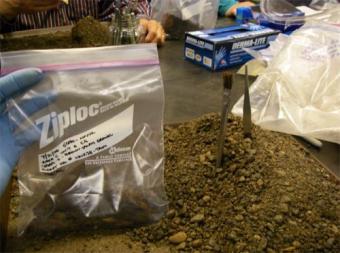 There is lots of little pieces out in the dig site. Most times, it is far more comfortable to sift through these samples while sitting in the comfortable lab and not out in the cold, windy, wet weather. See if you can find three archaeology tools in the picture.
There is lots of little pieces out in the dig site. Most times, it is far more comfortable to sift through these samples while sitting in the comfortable lab and not out in the cold, windy, wet weather. See if you can find three archaeology tools in the picture.
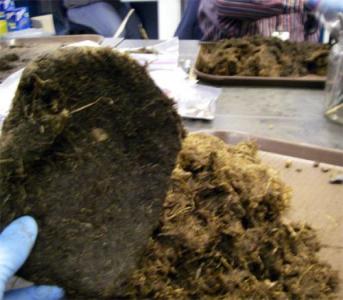 The field work generates so much material to examine that it often takes months to look at all of the material that is collected. The amount of fun in the job probably influences when it is examined as well. The peat samples have to be pulled apart, basically strand by strand, to determine if there are animal bones, wood fragments, or chert fragments.
The field work generates so much material to examine that it often takes months to look at all of the material that is collected. The amount of fun in the job probably influences when it is examined as well. The peat samples have to be pulled apart, basically strand by strand, to determine if there are animal bones, wood fragments, or chert fragments.
The work is pretty slow, you have to look closely and there is quite a bit of material to go through. What is exciting is finding things and then cleaning them up. As I was working through this, I felt just like an archaeologist!!
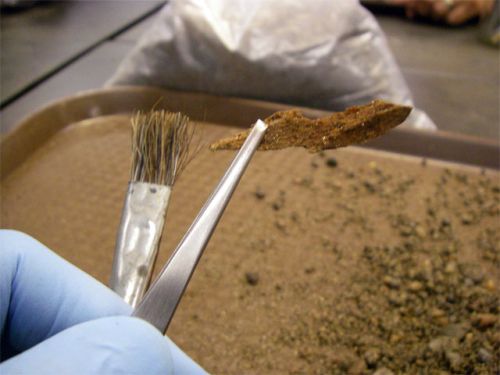 Lab tools and a small wood sample. Low tech with interesting results. What questions could be asked about the sample of wood? Send them in to "Ask the Team" and compare your questions to our questions.
Lab tools and a small wood sample. Low tech with interesting results. What questions could be asked about the sample of wood? Send them in to "Ask the Team" and compare your questions to our questions.
The lab in general is a very interesting piece. When I first walked in, I gazed around and saw all sorts of neat, science stuff. Here are a few of the discoveries I made in the lab.
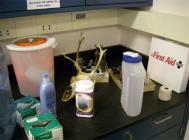 Caribou skull, First Aid Kit, Kimwipes, and all sorts of interesting stuff are in this corner of the lab.
Caribou skull, First Aid Kit, Kimwipes, and all sorts of interesting stuff are in this corner of the lab.
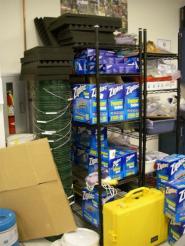 The lab equipment used by archaeologists can be high tech or low tech. In this picture, you see lots of low tech equipment. What do you think all the ziploc bags are for? Send an answer to "Ask the Team".
The lab equipment used by archaeologists can be high tech or low tech. In this picture, you see lots of low tech equipment. What do you think all the ziploc bags are for? Send an answer to "Ask the Team".
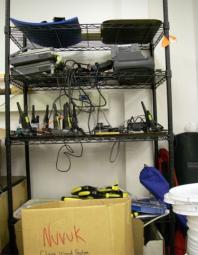 Here are some more lab equipment shelves. This is the high tech stuff, with some low-tech tape measures. Why would walkie-talkies be needed? Send an answer to "Ask the Team."
Here are some more lab equipment shelves. This is the high tech stuff, with some low-tech tape measures. Why would walkie-talkies be needed? Send an answer to "Ask the Team."
The artifacts in the lab will all be examined, recorded, analyzed and then stored for future use. To avoid any mistakes, everything is labeled. Here is an artifact and it’s label. The label is critical, it gives all the info a person would need to be able to go back, find the object on a map, and much more.
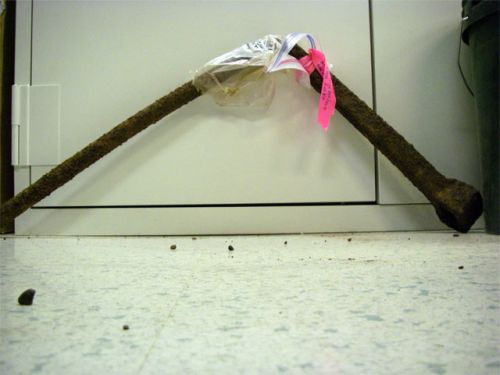 This object was found out at the Nuvuk site. What could it be? Where would it have come from? When did metal materials first come up here? Archaeology is all about asking questions and gathering information to find an answer.
This object was found out at the Nuvuk site. What could it be? Where would it have come from? When did metal materials first come up here? Archaeology is all about asking questions and gathering information to find an answer.
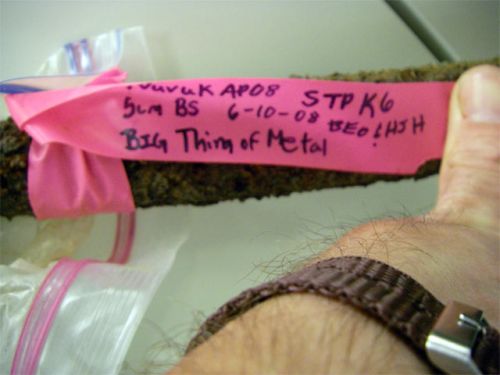 The lab tag reads: First Line: Nuvuk AP08 STP K6, 5CM BS, 6/10/08, BEO & HJH, Big Thing of Metal. What does all that info mean? Why is it important? And what is it? The tag means: Nuvuk Archaeology Project 2008, Shovel Test Pit, Line K, 6 meters along the line, 5 cm below the surface, found on June 10, 2008, Discovered by BEO and HJH (the people's initials)
The lab tag reads: First Line: Nuvuk AP08 STP K6, 5CM BS, 6/10/08, BEO & HJH, Big Thing of Metal. What does all that info mean? Why is it important? And what is it? The tag means: Nuvuk Archaeology Project 2008, Shovel Test Pit, Line K, 6 meters along the line, 5 cm below the surface, found on June 10, 2008, Discovered by BEO and HJH (the people's initials)
Tomorrow I will be giving a general overview of the community out here at BASC (Barrow Arctic Science Center). Thanks for checking out the journal. Feel free to ask questions, and keep an eye out for fireflies down there!!

